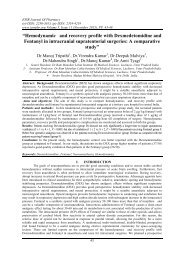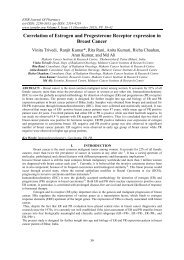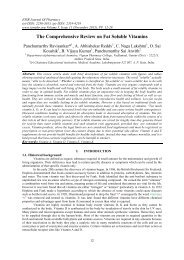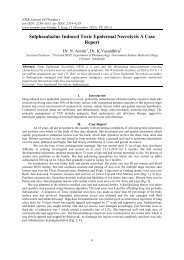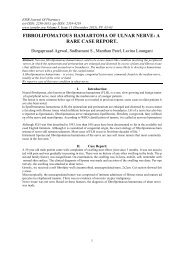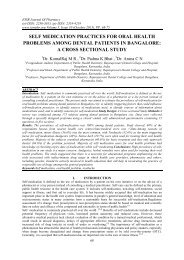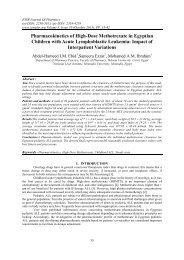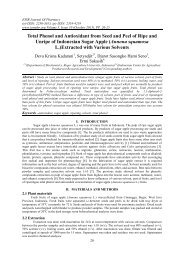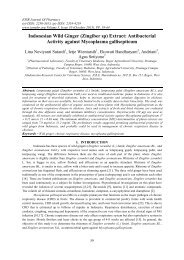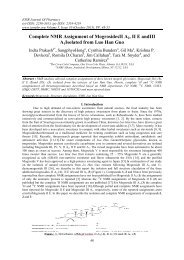Nanoemulsion and Nanoemulgel as a Topical Formulation
Nanoemulsion is referred type of emulsion with uniform and extremely small droplet size in the range of 20-200 nm. Nanoemulsion provides numerous advantages over other carrier such as polymeric nanoparticle and liposomes, including low cost preparation procedure, high hydrophilic and lipophilic drug loading system to enhance the longer shelf live upon preserving the therapeutic agents. Incorporating the preparation of nanoemulsion with hydrogel matrix to produce nanoemulgel exhibited by the two separate systems that forming it. Nanoemulgel possesses the properties of thixotropic, non-greasy, effortlessly spreadable, easily be removed, emollient, not staining, soluble in water, longer shelf life, bio-friendly, translucent and agreeable appearance.
Nanoemulsion is referred type of emulsion with uniform and extremely small droplet size in the range of 20-200 nm. Nanoemulsion provides numerous advantages over other carrier such as polymeric nanoparticle and liposomes, including low cost preparation procedure, high hydrophilic and lipophilic drug loading system to enhance the longer shelf live upon preserving the therapeutic agents. Incorporating the preparation of nanoemulsion with hydrogel matrix to produce nanoemulgel exhibited by the two separate systems that forming it. Nanoemulgel possesses the properties of thixotropic, non-greasy, effortlessly spreadable, easily be removed, emollient, not staining, soluble in water, longer shelf life, bio-friendly, translucent and agreeable appearance.
You also want an ePaper? Increase the reach of your titles
YUMPU automatically turns print PDFs into web optimized ePapers that Google loves.
IOSR Journal Of Pharmacy<br />
(e)-ISSN: 2250-3013, (p)-ISSN: 2319-4219<br />
www.iosrphr.org Volume 5, Issue 10 (October 2015), PP. 43-47<br />
<strong>Nanoemulsion</strong> <strong>and</strong> <strong>Nanoemulgel</strong> <strong>as</strong> a <strong>Topical</strong> <strong>Formulation</strong><br />
Padmadevi Chellapa 1 ,Aref T. Mohamed 2 , Eseldin I. Keleb 2 , Assad<br />
Elmahgoubi 3 , Ahmad M. Eid 1,4 ,Yosef S. Issa 5 , Nagib A. Elmarzugi 1,2,3,*<br />
1 Research <strong>and</strong> Innovation Dept., Institute of Bioproduct Development, Universiti Teknologi Malaysia, 81310<br />
UTM, Johor, Malaysia.<br />
2 Dept. of Industrial Pharmacy, Faculty of Pharmacy, Tripoli University, Tripoli, Libya.<br />
3 BioNano Integration Research Group, Biotechnology Research Center, LARST, Libya.<br />
4 Dept. of Pharmacy, Faculty of Medicine, An-Najah National University, Nablus, Palestine.<br />
5 Faculty of Medicine, Tripoli University, Tripoli, Libya.<br />
Abstract: <strong>Nanoemulsion</strong> is referred type of emulsion with uniform <strong>and</strong> extremely small droplet size in the range<br />
of 20-200 nm. <strong>Nanoemulsion</strong> provides numerous advantages over other carrier such <strong>as</strong> polymeric nanoparticle<br />
<strong>and</strong> liposomes, including low cost preparation procedure, high hydrophilic <strong>and</strong> lipophilic drug loading system<br />
to enhance the longer shelf live upon preserving the therapeutic agents. Incorporating the preparation of<br />
nanoemulsion with hydrogel matrix to produce nanoemulgel exhibited by the two separate systems that forming<br />
it. <strong>Nanoemulgel</strong> possesses the properties of thixotropic, non-gre<strong>as</strong>y, effortlessly spreadable, e<strong>as</strong>ily be removed,<br />
emollient, not staining, soluble in water, longer shelf life, bio-friendly, translucent <strong>and</strong> agreeable appearance.<br />
Keywords-<strong>Nanoemulsion</strong>, <strong>Nanoemulgel</strong>, Emulsifying method, Liposomes, Thixotropic, Hydrogel<br />
I. Introduction<br />
Emulsion <strong>as</strong> a dispersed system, which consists of small droplets which is well distributed in to<br />
immiscible vehicle [1].The types of emulsions which cl<strong>as</strong>sified in according to their droplets size, are<br />
Macroemulsion (droplet of 1 to 100 µm of diameter) also known <strong>as</strong> the conventional emulsion/colloid. It is<br />
commonly unstable with droplets sediment or float with the dispersing ph<strong>as</strong>e <strong>and</strong> medium ph<strong>as</strong>e b<strong>as</strong>ically,<br />
unstable with absorption of solid particles on the surface [2]. Where<strong>as</strong>, microemulsion (droplet between 10-100<br />
nm) is an isotropic liquid system with more uniform size <strong>and</strong> good physiochemical properties [3] <strong>and</strong><br />
nanoemulsion (droplet size 20-200 nm diameter) is more stable <strong>and</strong> requires less emulsifying agent.<br />
<strong>Nanoemulgel</strong> is known <strong>as</strong> the formation of nanoemulsion b<strong>as</strong>ed hydrogel by the addition of<br />
the nanoemulsion system intergraded into hydrogel matrix which influences a better skin penetration<br />
[4].<br />
II. <strong>Nanoemulsion</strong><br />
2.1 <strong>Nanoemulsion</strong> in <strong>Topical</strong> Application<br />
<strong>Nanoemulsion</strong> is a promising alternative to incre<strong>as</strong>e drug delivery system penetration <strong>and</strong> targeting<br />
poorly soluble drugs, by incre<strong>as</strong>ing its absorption through the skin, better retention time of drug in the target<br />
area <strong>and</strong> eventually result in less side effects [5]. The benefits of nanoemulsion with globules in nano-scale size<br />
of an emulsion does not relay on the emulsion physical properties itself [6], yet encounter the bioavailability of<br />
therapeutic drugs in whole. Apparently, there have been researches on the bioavailability of lacidipine via<br />
transdermal route w<strong>as</strong> 3.5 times higher than that of oral route which believed to be due to avoidance of first-p<strong>as</strong>s<br />
metabolism [7].<br />
Besides that, nanoemulsion improves the permeation of drug through skin, which intergrade the<br />
interest of researchers. In addition, the small size of particles, the more amount of drug is able to be incorporated<br />
in the formulation, which subsequently incre<strong>as</strong>es the thermodynamics towards the skin. Moreover, the drug<br />
affinity for partitioning incre<strong>as</strong>es permeation into the skin [7].<br />
One of the studies consequently narrates the implications of Nile red (NR) dye loaded in lecithin<br />
nanoemulsion w<strong>as</strong> able to penetrate the skin 9.9-fold greater than the NR-loaded general emulsion [8]. Besides<br />
that, ingredients used in the formulation consisting of ethyl oleate <strong>and</strong> propylene glycol, also act <strong>as</strong> permeation<br />
enhancers [9].<br />
The greatest obstacle upon transdermal drug delivery refers to barrier properties of stratum corneum a<br />
10 µm to 20 µm thick tissue layer with great composed structured lipid/protein matrix [10]. On recent study, of<br />
topical delivery lipophilic flurbiprofen in nanoemulsion proves an incre<strong>as</strong>e in bioavailability by 4.4 times<br />
compared to oral administration [11]. Hence, the nanoemulsion <strong>as</strong> spontaneous emulsifying method which<br />
43
<strong>Nanoemulsion</strong> <strong>and</strong> <strong>Nanoemulgel</strong> <strong>as</strong> A <strong>Topical</strong>..<br />
provides numerous advantages over other carrier such <strong>as</strong> polymeric nanoparticle <strong>and</strong> liposomes, including low<br />
cost preparation procedure, high hydrophilic <strong>and</strong> lipophilic drug loading system to enhance the longer shelf live<br />
upon preserving the therapeutic agents [11].<br />
2.2 Limitation of <strong>Nanoemulsion</strong> <strong>as</strong> <strong>Topical</strong> Applications<br />
In the formulation of nanoemulsion <strong>as</strong> a topical drug delivery faces many challenges in delivering drug<br />
effectively through the skin which rates controlling barrier for topical drug delivery [12]. Small particle sized<br />
formulation yet concerned when delivering drug through the skin, the rheology properties of nanoemulsion is<br />
important. The nanoemulsion formulation, it is not convenient to be used due to low viscosity <strong>and</strong> spreadability<br />
is noted [13].<br />
Hence, the limitation h<strong>as</strong> restrained the application of nanoemulsion clinically [14]. Therefore, the<br />
approach of incorporation of nanoemulsion with gelling system can help in overcoming this problem.<br />
III. <strong>Nanoemulgel</strong><br />
<strong>Nanoemulgel</strong> which known <strong>as</strong> the formation of nanoemulsion b<strong>as</strong>ed on hydrogel is the addition of<br />
nanoemulsion system intergraded into hydrogel matrix which influences a better skin penetration [4]. This<br />
mixture of nanomulgel h<strong>as</strong> attracted the attention of many scientists for the development of numerous drugs that<br />
function to treat various kinds of skin disorders.<br />
Emulgel is not a new type of formulation <strong>and</strong> are already present in the market <strong>as</strong> shown in Table 1. On<br />
the other h<strong>and</strong>, Table 2 shows the example of nanoemulgel or microemulgel formulations that had been<br />
prepared before.<br />
The formulation of nanoemulgel for the topical delivery system acts <strong>as</strong> drug reservoirs which, influence<br />
the rele<strong>as</strong>e of drugs from the inner ph<strong>as</strong>e to the outer ph<strong>as</strong>e <strong>and</strong> then further onto the skin [14]. These rele<strong>as</strong>e<br />
mechanism depends on the composition of the network polymer chains <strong>and</strong> the crosslink density [15].<br />
Besides that, the ability of a drug to permeate the skin <strong>and</strong> successfully rele<strong>as</strong>e of therapeutic agent is<br />
influenced by drug affinity to diffuse out from the vehicle <strong>and</strong> permeate through barrier [16].<br />
<strong>Nanoemulgel</strong> on intact with skin will rele<strong>as</strong>e the oily droplets from the gel network. The oil droplets<br />
then will penetrate into the stratum corneum of the skin <strong>and</strong> directly deliver the drug molecules without a<br />
transfer via hydrophilic ph<strong>as</strong>e of nanoemulsions [14].<br />
Table 1: Product of Emulgel Present in the Current Market<br />
Name of product Manufacturer <strong>Formulation</strong><br />
VoltarenEmulgel © Novartis Consumer Health Active ingredient: 100 g Diclofenac<br />
diethylamine corresponding to 1g<br />
diclofena sodium, propylene glycol.<br />
B<strong>as</strong>e: Fatty emulsion in an aqueous gel<br />
to which isopropanol <strong>and</strong> propylene<br />
glycol have been added.<br />
ReumadepEmulgel © ErbozetaEnergia Verde Arnica, Ashwag<strong>and</strong>ha, Myrrh, Ginger,<br />
Rosemary, Cloves, Mint.<br />
EmulgelLevoragMonodose © THD LAB Farmaceutici<br />
MeloxicEmulgel © Provet Meloxicam<br />
BenzolaitAzEmulgel © Rordermal Benzoylperossido 10%<br />
Coolnac Gel Emulgel 1 % © Chumchon Diclofenac Diethylammonium<br />
Table 2: Researches on <strong>Nanoemulgel</strong> or Microemulgel <strong>Formulation</strong>s<br />
Authors Year <strong>Formulation</strong><br />
Huabinget al. 2007 Microemulsion-b<strong>as</strong>ed hydrogel formulation of ibuprofen.<br />
Mouet al. 2008 Hydrogel-thickened nanoemulsion system (HTN) of mixture of<br />
camphor, menthol <strong>and</strong> methyl salicylate.<br />
Gannuet al. 2010 Lacidipine microemulsion-b<strong>as</strong>ed gel<br />
Fouad et al. 2013 Poloxamermicroemulsion-b<strong>as</strong>ed gel<br />
Khuranaet al. 2013 <strong>Nanoemulsion</strong>-b<strong>as</strong>ed gel of meloxicam<br />
Eid et al. 2014 Swietenia macrophylla <strong>Nanoemulgel</strong>.<br />
44
45<br />
<strong>Nanoemulsion</strong> <strong>and</strong> <strong>Nanoemulgel</strong> <strong>as</strong> A <strong>Topical</strong>..<br />
3.1 Advantages of <strong>Nanoemulgel</strong><br />
A stable nanoemulsion formulation is enhanced through nanoemulgel, by decre<strong>as</strong>ing surface <strong>and</strong><br />
interfacial tension <strong>and</strong> which leads the viscosity of the aqueous ph<strong>as</strong>e to be incre<strong>as</strong>ed [18]. Emulsifier <strong>and</strong><br />
thickeners been added to hold the gelling capability of hydrogel serves a better stability, permeation <strong>and</strong><br />
suitable viscosity for the delivery of topical drug-loaded nanoemulsion.<br />
In <strong>Nanoemulgel</strong> system, the stability of nanoemulsion is enhanced by the distribution of oily droplets<br />
in gel network [14]. These oily droplets function <strong>as</strong> carrier for drugs, such <strong>as</strong> lipophilic drug. The stability of<br />
drugs loaded in the system is determined by the affinity of the drug to be solubilized in the oil ph<strong>as</strong>e.<br />
<strong>Nanoemulgel</strong> attained a good adhesion property on the skin together with high solubilizing capacity leads to<br />
larger concentration gradient towards the skin that influence further skin penetration of drug <strong>as</strong> it move down<br />
the gradient.<br />
Moreover, the <strong>Nanoemulgel</strong> formulation is known to support better delivery of lipophilic <strong>and</strong> poorly<br />
soluble drugs <strong>as</strong> shown in Table 3. It also promotes improve patient compliance because the formulation is not<br />
sticky <strong>and</strong> e<strong>as</strong>ily spread <strong>as</strong> compared to other topical delivery system such <strong>as</strong> ointment <strong>and</strong> cream which are<br />
very sticky, troubled upon application <strong>and</strong> have reduced spreading coefficient, hence they require the<br />
mechanism of rubbing. Besides that, nanoemulgel helps in controlling the rele<strong>as</strong>e of drugs by extending the<br />
effect of drugs having shorter half-life [19].<br />
Table 3: Research on Bioavailability of Lipophilic Drug in <strong>Nanoemulgel</strong> <strong>and</strong> Microemulgel through<br />
Skin Penetration<br />
Author Year Research Outcome<br />
Gannuet al. 2010 Enhanced availability of<br />
lacidipine via<br />
microemulsion b<strong>as</strong>ed<br />
transdermal gels.<br />
Azeemet al. 2012 To investigate the<br />
pharmacokinetic <strong>and</strong><br />
biochemical of the oil<br />
b<strong>as</strong>ed nanocarrier system<br />
for transdermal delivery of<br />
ropinirole.<br />
El –Hadidyet al. 2012 Microemulsions <strong>as</strong><br />
vehicles for topical<br />
administration of<br />
voriconazole: formulation<br />
<strong>and</strong> in vitro evaluation.<br />
Khuranaet al. 2013 Formulate nanoemulsion<br />
b<strong>as</strong>ed gel for transdermal<br />
delivery of meloxicam.<br />
The study on bioavailability of lacidipine<br />
(LCDP) w<strong>as</strong> found to be C MAX = 110.0 ng<br />
mL -1 (microemulgel) <strong>and</strong> 97.4 ng mL -1 (oral<br />
suspension). It w<strong>as</strong> revealed that LCDP<br />
penetrated well by transdermal route.<br />
Through nanoemulsion gel formulation,<br />
ropinirole exhibit improved penetration<br />
through the skin <strong>and</strong> extended rele<strong>as</strong>e.<br />
Furthermore, the bioavailability of<br />
ropiniroleis twice improved than gel<br />
formulation available in the market.<br />
Results also indicated that in nanoemulgel<br />
formulations (BG4-BG6) <strong>as</strong> the surfactant<br />
co-surfactant mixture concentration w<strong>as</strong><br />
decre<strong>as</strong>ed from 55% to 35% the skin<br />
permeation rate w<strong>as</strong> incre<strong>as</strong>ed to two-fold.<br />
The re<strong>as</strong>on attributed to the situation could<br />
be an incre<strong>as</strong>e in thermodynamic activity of<br />
drug in nanoemulgel at lower content of<br />
surfactant.<br />
The study on bioavailability of meloxicam<br />
nanoemulsion (MLX-NE) gel <strong>and</strong> MLX<br />
solution, via skin permeation, give outcome<br />
of 344.061 +/- 1.49 µg <strong>and</strong> 186.34 +/- 1.66<br />
µg respectively.<br />
MLX-NE h<strong>as</strong> higher penetration ability than<br />
solution formulation.<br />
Skin permeation of lipophilic meloxicam<br />
showed better penetration in nanoemulsion<br />
gel when analysed through confocal l<strong>as</strong>er<br />
screening microscopy (CLSM).<br />
The nanoemulsion gel incorporated with<br />
Rhodamine 123 (lipophilic fluorescent<br />
marker) showed deeper penetration into the<br />
rat skin which can reach up to 130µm<br />
compared to solution formulation of only<br />
20µm.
<strong>Nanoemulsion</strong> <strong>and</strong> <strong>Nanoemulgel</strong> <strong>as</strong> A <strong>Topical</strong>..<br />
Arora et al. 2014 The aim of the present<br />
study w<strong>as</strong> to investigate<br />
the nanoemulgel <strong>as</strong><br />
transdermal delivery<br />
system for poorly water<br />
soluble drug, ketoprofen,<br />
in order to overcome the<br />
troubles <strong>as</strong>sociated with its<br />
oral delivery. Different<br />
nanoemulsion<br />
components(oil,<br />
surfactant,<br />
<strong>and</strong><br />
cosurfactant) were<br />
selected on the b<strong>as</strong>is of<br />
solubility<br />
<strong>and</strong><br />
emulsification<br />
ability.Pseudoternary<br />
ph<strong>as</strong>e diagrams were<br />
constructed using titration<br />
method to figure out the<br />
concentration range<br />
Transdermal permeation of ketoprofen from<br />
nanoemulgels w<strong>as</strong> determined by using<br />
Franz diffusion cell. <strong>Nanoemulgel</strong><br />
containing 6% oleic acid <strong>as</strong> oil, 35% Tween<br />
80, <strong>and</strong> Transcutol P <strong>as</strong> surfactant<br />
cosurfactant mixture, 56.5% water, 2.5%<br />
drug, <strong>and</strong> 0.6% carbomerw<strong>as</strong> concluded <strong>as</strong><br />
optimized formulation (NG6). The ex vivo<br />
permeation profile of optimized formulation<br />
w<strong>as</strong> compared with nanoemulsion <strong>and</strong><br />
marketed formulation (F<strong>as</strong>tum).<br />
IV Summary<br />
<strong>Nanoemulsion</strong>s are non-equilibrium, thermodynamically stable optically transparent, met<strong>as</strong>table<br />
dispersion of nano-sized particles having defined surface tension formed by certain shear, comprises of a<br />
suitable oil <strong>and</strong> definite blend of surfactants <strong>and</strong> co-surfactants <strong>and</strong> having capacity to dissolve large quantities<br />
of hydrophobic drugs. The stabilization system possesses the stability sedimentation or creaming.<br />
In addition, breakdown of the particles into nano-scaled sizes, the system h<strong>as</strong> the ability to attain low<br />
polydispersity. The physicochemical <strong>and</strong> biological properties of nanoemulsion deviate from the cl<strong>as</strong>sical<br />
emulsion properties.<br />
<strong>Nanoemulsion</strong> system can be achieved through homogenizers, low energy emulsification <strong>and</strong> ph<strong>as</strong>e<br />
inversion temperature methods. On top of that, there are so many conflicts regarding suitable method of<br />
preparation of nanoemulsions <strong>and</strong> later on it w<strong>as</strong> proved that nanoemulsions can be formulated by low-energy<br />
emulsification method along with high shear homogenizer method.<br />
<strong>Nanoemulgel</strong> is also known <strong>as</strong> hydrogel-thickened nanoemulsion (HTN) since the system is showing<br />
an increment in viscosity compared to the nanoemulsion system. A stable nanoemulsion formulation is<br />
enhanced through nanoemulgel, by decre<strong>as</strong>ing surface <strong>and</strong> interfacial tension which leads viscosity of the<br />
aqueous ph<strong>as</strong>e incre<strong>as</strong>ed.<br />
References<br />
[1] Lieberman, H.A., M.M. Rieger, <strong>and</strong> G.S. Banker, Pharmaceutical Dosage Forms Disperse Systems Emulsion <strong>and</strong><br />
Microemulsions, 2, 2014,p. 335-369.<br />
[2] Shaji, K.P., S. Umesha, <strong>and</strong> B.P. Salimath, A Novel Liquid Oral <strong>Formulation</strong> For 1- Octacosanol An Anticancer Drug <strong>and</strong> Its<br />
Stability Study.Indian Journal of Research in Pharmacy <strong>and</strong> Biotechnology, 3(3), 2012, p. 186.<br />
[3] Mestres, G.M. <strong>and</strong> F. Nielloud, Emulsions of Health Care Applications An Overview.Journal of Dispersions Science <strong>and</strong><br />
Technology,23(1-3), 2002, p. 419-439.<br />
[4] Sigh, R.P., et al., Emulgel: A Recent Approach For <strong>Topical</strong> Drug Delivery System,Asian Journal of Pharmaceutical Research<br />
<strong>and</strong> Development, 2(2), 2014, p. 13-15.<br />
[5] Sutradhar, K.B. <strong>and</strong> L. Amin, <strong>Nanoemulsion</strong>: incre<strong>as</strong>ing possibilities drug delivery,European Journal of Nanomedicine,5(2),<br />
2013, p. 97-110.<br />
[6] Fern<strong>and</strong>ez, P., et al., <strong>Nanoemulsion</strong> <strong>Formulation</strong> by emulsion ph<strong>as</strong>e inversion,Colloid <strong>and</strong> Surfaces A : Physiochemical <strong>and</strong><br />
Engerinering Aspects, 251(1),2004, p. 53-58.<br />
[7] Gannu, R., et al., Enhanced bioavailability of lacidipine via microemulsion b<strong>as</strong>ed transdermal gels: formulation optimization ex<br />
vivo <strong>and</strong> in vivo characterization,International Journal of Pharmaceutics, 388(1-2),2010, p. 231-241.<br />
[8] Zhao, Y., et al., Self-nanoemulfying drug delivery system (SNEDSS) for oral delivery Zeodary essential oil: formulation <strong>and</strong><br />
bioavailability studies,International Journal of Pharmaceutics, 383(1), 2010, p. 170-177.<br />
[9] Chen, H., et al., Hydrogel-thickened microemulsion for topical administration of drug molecule at an extremely low<br />
concentration,International Journal of Pharmaceutics, 341(1-2), 2007, p. 78-84.<br />
[10] Cevc, G., Lipid vesicles <strong>and</strong> other colloids <strong>as</strong> drug carriers on the skin,Advanced Drug Delivery Reviews, 56(5), 2004, p. 675-<br />
711.<br />
[11] Bh<strong>as</strong>kar, K., et al., Lipid Nanoparticles for transdermal delivery of flurbiprofen: formulation, in vitro ,ex-vivo <strong>and</strong> in vivo<br />
studies,Lipids in Health <strong>and</strong> Dise<strong>as</strong>e, 8(6),2009.<br />
46
<strong>Nanoemulsion</strong> <strong>and</strong> <strong>Nanoemulgel</strong> <strong>as</strong> A <strong>Topical</strong>..<br />
[12] Kong, M., et al., Investigestions on skin hyaluronic acid b<strong>as</strong>ed on naoemulsion <strong>as</strong> transdermal carrier,Carbohydrates<br />
polymer,86(2), 2011, p. 837-843.<br />
[13] Khurana, S., N.K. Jain, <strong>and</strong> P.M.S. Bedi, <strong>Nanoemulsion</strong> b<strong>as</strong>ed gel for transdermal delivery of meloxicam: Physico-chemical,<br />
mechanistic investigation,Life Sciences, 92(6–7),2013, p. 383-392.<br />
[14] Mou, D., et al., Hydrogel thickened nanoemulsion sistem for topical delivery of lipophilic drugs,International journal of<br />
pharmaceutiucs,35(1),2008, p. 270.<br />
[15] Bernard, P.B., Modern Aspects of Emulsion Science,Emulsions -Recent Advances in Underst<strong>and</strong>ing, UK: Royal Science of<br />
Chemistry, 2012.<br />
[16] Alves, M.P., et al., Human Skin Penetration <strong>and</strong> Distribution of Nimesulide from Hydrofilic Gels,International Journal<br />
Pharmaceutics, 314(1-2),2007, p. 215-220.<br />
[17] Fouad, S.A., et al., Microemulsion <strong>and</strong> poloxamer microemulsion-b<strong>as</strong>ed gel for sustanined transdermal delivery of diclofenac<br />
epolamine using in-skin drug depot : In vitro/ In vivo evaluation,International Journal of Pharmaceutics, 453(2),2013, p. 569-<br />
578.1<br />
[18] Babihav, J., et al., A Comprehensive Review On the View Recent Advances In <strong>Topical</strong> Drug Delivery 2(11), 2011, p. 66-70.<br />
[19] Panwar, A.S., et al., A Review: Emulgel,Asian Journal of Pharmacy <strong>and</strong> Life Science, 1(3),2011.<br />
[20] El-Hadidya, G.N., et al., Microemulsions <strong>as</strong> Vehicles for <strong>Topical</strong> Administration of Voriconazole: <strong>Formulation</strong> <strong>and</strong> In Vitro<br />
Evaluation,Drug Development <strong>and</strong> Industrial Pharmacy, 38(1),2011, p. 64-72.<br />
[21] Arora, R., et al., <strong>Nanoemulsion</strong> B<strong>as</strong>ed Hydrogel for Enhanced Transdermal Delivery of Ketoprofen,Advances in Pharmaceutics,<br />
2014(1), 2011, p. 12.<br />
47




